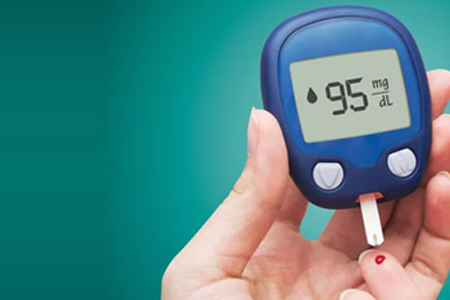
DIABETES
- December 11, 2018
- Posted by Vaidya Jagjit Singh
- 0 Comment(s)
Diabetes, which is also called Diabetes Mellitus by doctors, refers to a group of metabolic diseases in which the person has high blood glucose;it is either because the insulin production is inadequate, or it can also be because the body’s cells don’t respond properly to insulin, or both the reasons combined. Pancreas is the organ that releases insulin in the body which helps it to store and use the sugar and fat from the food that a person eats.
It affects how the body uses blood sugar(glucose) which is very vital part as it is the main source of to the cells which make up muscles and tissues apart from being the main source of fuel for the brain.In the worst case scenario it can cause blindness, amputations, kidney failure, failure and stroke.
Table of Contents
CAUSES
Type 1 diabetes
The exact cause of why type 1 diabetes happens is unknown. But the reason for it is that the immune system, which normally fights harmful bacteria or viruses, starts attacking and destroying the insulinproducing cells in the pancreas. This deprives the body with enough or no insulin at all. Therefore the sugar instead of being transported into your cells, builds up in the bloodstream.
Type 1diabetes is thought to be caused by a combination of genetic susceptibility and certain environmental factors, though what those factors are is still unclear. However a person’s weight is not believed to be a factor in type 1 diabetes.
Prediabetes and type 2 diabetes
In prediabeteswhich can lead to type 2 diabetes and in type 2 diabetes, the cells of the body become resistant to the action of insulin, and the pancreas is unable to overcome this resistance as it can’tproduce enough insulin . Therefore the sugar instead of moving into your cells where it’s needed for energy, builds up in the bloodstream.
Exactly what leads to this is still uncertain, although it’s believed that genetic and environmental factors play a role in the development of type 2 diabetes too. Moreover being overweight is strongly linked to the development of type 2 diabetes, but not everyone with type 2 is overweight therefore it is not the main cause.
Gestational diabetes
During pregnancy, the placenta produces hormones to sustain your pregnancy, however these hormones tend to make your cells more resistant to insulin.
Usually, the pancreas responds by producing enough extra insulin to overcome this resistance. But sometimes your pancreas can’t keep up with this demand or fails to produce sufficient extra insulin. And due to this lack of insulin, insufficient amounts of glucose gets into the cells and too much of it remains in the blood, resulting in gestational diabetes.
SYMPTOMS
- Those who are not treated urinate frequently
- They feel excessively thirsty
- They usually feel very tired
- They experience severe weight loss despite normal or excessive food intake
- Those with type 2 diabeteswho do not have their blood glucose under control tend to experience a persistent mild thirst
- They sometimes have complaints of blurred visions
- Mostly the women have recurring vaginal yeast infections
- Both men and women are prone to yeast infections in any warm, moist fold of skin
- There can also be pain and numbness in feet or legs due to nerve damage
- The high blood sugar over a long period of time can affect the blood flow and cause nerve damage that makes it hard for the body to heal wounds normally as they usually do
TYPES
Type 1 diabetes
It is also known as insulin-dependent diabetes or juvenile diabetes because it usually develops in children or teenagers, though it can develop at any age. It is a more severe form as the body’s immune system attacks parts of its own pancreas as it mistakenly sees the insulin producing cells in the pancreas as foreign and destroys them.
Type 2 diabetes
It is also called non-insulin dependent diabetes or adult onset diabetes since it typically develops after the age of 35, however a growing number of people are now developing it at a younger age. It is generally tied to people with a sedentary lifestyle and is overweight.
Those who have type 2 diabetes are able to produce some of their own insulin but often it is not enough. The insulin serves as a key to open body’s cells to absorb glucose. But because of insulin resistance the key won’t work and the cells won’t open.
AYURVEDIC TREATMENT
BaidyanathMadhumehri
It controls sugar levels and reduces frequent urination. One teaspoon is to be consumed before meals.
Diabex
For Severe cases 2 pills are to be taken thrice a day before meals and for moderate cases 2 pills to be taken before breakfast and dinner and 1 pill before breakfast and dinner for Borderline Cases. This medicine curtails the symptoms of type 2 diabetes.
VK4 Diacon
One tablet is to be consumed twice a day along with water. This medicine is for both type 1 and type 2 patients.
Bitter Gourd Juice
It is supposed to be taken on an empty stomach daily early in the morning. 30 ml is considered a decent amount to be consumed. It helps in increasing insulin secretion.
Neem Leaves, Tulsi Leaves, and Belpatras
The extracts of the three can be mixed together and one tablespoon of the mixture is to be consumed with water on an empty stomach. This reduces the content of sugar in the blood.
Bael leaves
The extract of the leaves can be consumed with black pepper or 15 ml of its juice can be consumed with 5 g of honey. This concoction can be consumed as medicine 3 times a day.
Ground Bay Leaf, Turmeric & Aloe Vera
Mix ground bay leaf 1/2 tablespoon, turmeric 1/2 tablespoon and aloe vera gel 1 tablespoon. This mixture is to be taken twice a day before both lunch and dinner.
Fenugreek seeds
The easiest way is soaking them overnight and consuming in the morning either just like that or grinded in the water in which they were soaked and consumed daily for at least 3 months.
Jamun
Leaves of jamun can be chewed to cure type 2 diabetes, about 4-5 of them twice a day. Also 1 tablespoon of ground dried jamun seeds can be consumed with lukewarm water twice a day.
Amla and cinnamon powder
These can be included in various forms in the daily diet. One can also mix Amalakichurna 500mg with turmeric powder 500mg and naagbhasma 125mg and consume at least one tablespoon of the mixture daily.
Vijaysar
It’s good for curing type 2 diabetes. Cubes can be consumed individually or soaked in water overnight and the water can be consumed on an empty stomach in the morning.
Triphala
The decoction of equal parts of Triphala, the root of barberry, colocynth, and moth 20mlcan be mixed and this liquid can be taken with turmeric powder 4gm twice a day. This lowers the sugar levels in the blood.
Banyan tree bark
50 mlof the decoction of the bark is to be consumed twice a day.
NATURAL REMEDIES
- Include whole grains in the diet.
- Use ingredients like garlic, bitter gourd, Onion, spinach, raw banana, and black plum in the diet.
- Avoid anything that is sweet, sour, salty and heavy, oily and spicy foods. Also avoid foods like potatoes, sweet potatoes, colocation (taro), yams, fresh grains and pulses (legumes), whole yogurt (high in fat), etc.
- Avoid sweet fruits like pineapple, watermelon, grapes, mangoes, etc.
- Any sort of light exercise daily is recommended. Like brisk walking for 40-50 minutes daily.
- Avoid sleeping in daytime.
- Yoga can be very effective in controlling diabetes. Sirsasana, Veerasana, Paschimotasana, Mayurasana and many other yoga poses are quite beneficial in treating both type 1 and type 2 diabetes.

Vaidya Jagjit Singh is a 3rd generation Ayurved physician from his family and is the remarkable person responsible for setting up of the Chandigarh Ayurved and Panchkarma Centre in sector 32 and 22, Chandigarh and Zirakpur and he is also the first founder member of Guru Ravidas Ayurved University. He has done his B.A.M.S. from Shri Dhanwantri Ayurvedic College, Chandigarh. He is an admirable ayurvedic physician with specialization in Chronic ailments.


